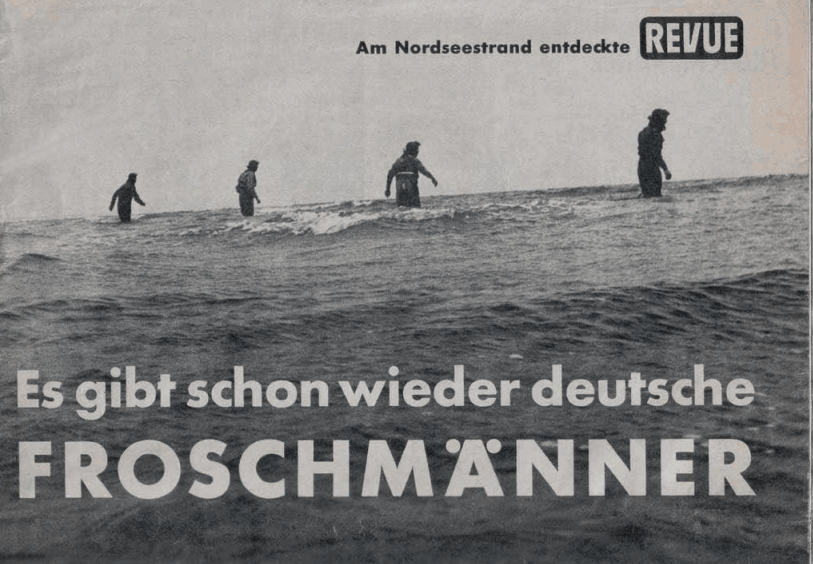
Die Wiedergeburt eines Seekriegsmittel
The Federal Republic of Germany (FRG) was founded on 23 May 1949 out of what had been the three western zones of occupation. The new federal government soon came under increasing pressure to rearm. The catalyst was a conflict taking place 15,000 kilometers southeast of German territory: the Korean War.
The Western powers realized that a major West German contribution to the common defense of Europe – over and above its role as a host for allied armed forces – was needed. Following secret consultations with the FRG’s Chancellor (head of government) Konrad Adenauer – and acting under his direction – 15 former officers of the wartime German armed forces met in a small monastery in the Eiffel mountains. Among the officers meeting at the Himmerod monastery was Vice Admiral Heye (who would later serve as the armed forces ombudsman of the German parliament). The result of this four-day meeting (5-9 October 1950) was the so-called Himmerod Memorandum. It would serve as the basis for Germany’s postwar rearmament and for the development of the postwar West German armed forces, the Bundeswehr (“Federal Defense Forces”), which formally began in 1955 after the Federal Republic of Germany’s accession to NATO.
On 23 October 1954 the Federal Republic of Germany was formally invited to join the North Atlantic Treaty Organisation; accession as a full member was accomplished on 6 May 1955. The FRG’s armed forces (Bundeswehr – Federal Defense Force) were formally established on 12 November 1955. The FRG’s navy (Bundesmarine) was established on 2 January 1956 and initially equipped with ships and boats from the Labor Service Unit.
Despite being one element of a greater allied “Atlantic navy”, the West German navy’s area of operations was clearly envisioned as being restricted to the North Sea and Baltic Sea. This vision then defined the navy’s organization and resource allocation. The Bundesmarine was specifically conceptualized to support allied operations and strategy. Its core strategic mission was centered on the Baltic and included both defensive and offensive operations, including amphibious landings to the rear of a potential Russian front. Admiral Heye emphasized the necessity for amphibious landings and commando operations. These operations had two goals: preventing enemy troops from landing on the coast in order to secure their own army flanks; and “conducting commando operations and landings deep behind the Russian front, to bind enemy forces and create uncertainty”. (Peter Monte, Die Rolle der Marine in der Verteidigungsplanung für Mittel- und Nordeuropa von den 50er Jahren bis zur Wende 1989/90) This line of planing would open a new chapter in German naval history: amphibious operations.
As in all service branches of the Bundeswehr, the founding members of the postwar navy were veterans of the wartime armed forces. Everyone assigned to a supervisory or command position had to undergo a strict vetting process. Those found innocent of war crimes or other wrongdoing could be accepted into the Bundeswehr. Some German politicians voiced doubts about accepting wartime personnel into the new armed forces. Chancellor Adenauer replied that NATO would not accept 18-year-old German generals.
The Amphibious Forces Command (Kommando der Amphibischen Streitkräfte) was established in Wilhelmshafen to create the requisite command structure for amphibious operations. In 1959 the Naval Combat Engineer Battalion (Marinepionierbataillon) was renamed Maritime Battalion (Seebataillon). It consisted of a boat company, a beachmaster company, a combat engineer company, and a command and support company.
In the course of developing amphibious capabilities the naval leadership realized that a Kampfschwimmer unit would also be required. At the time in question every NATO navy with amphibious forces also had a naval commando unit. But the knowledge required for developing such a unit was virtually non-existent in the new German navy. Moreover, the German armed forces had missed out on the preceding ten years worth of military developments. So how could the skills be acquired?
Requests for assistance in standing up a naval commando unit were made to various NATO partners, and France offered to help. Why France?
“Following WWII the French had systematically pursued modernization of naval commando equipment and tactics. The French underwater warfare laboratory led by Jacques Cousteau developed improved diving equipment optimized for military operations. So where does a developed system prove itself? The French found their opportunity in the Indochina War. The experience fained in this war shaped the Nageur de Combat [‘Combat Swimmer’] who did not have much left in common with the combat swimmers of World War II. Back then, the combat swimmer’s field of operation lay exclusively in the water, but now he also went ashore and continued his mission there.” [Kapitänleutnant (Lieutenant) (ret.) Ulrich Wolfgang Sassen in a lecture titled: Kampfschwimmereinsätze in der Vergangenheit – Erfolge in der Zukunft (Naval Commando Missions of the Past – Success in the Future) .
The cadre personnel of the new German Kampfschwimmer unit attended a six-month training program at the French naval commando school in St. Mandrier in the south of France from January to July 1959. This initial cadre consisted of only two men, both veterans of the WWII Kampfschwimmer unit: Kapitänleutnant (O-3, Lieutenant) Günter Heyden and Maat (Petty Officer) Fred Langhans. Following procurement of equipment for the new unit, the German Navy was ready to begin its own training program in Germany,on the North Sea island of Sylt.
The first postwar Kampfschwimmer training course began on 1 July 1959 under supervision of Kapitänleutnant Herbert Völsch (known to his men as “Papa Völsch”) and Oberbootsmann (Chief Petty Officer) Walter Prasse. The initial class consisted of 13 hand-picked trainees, including three petty officers and ten seamen. “One month later the first Kampfschwimmer platoon was activated and assigned to the Seebataillon in Sengwarden, with detachments at Eckernförde and Borkum.” (Froschmänner, Eric Micheletti).
At this point the platoon’s primary capabilities spectrum was still restricted to maritime special reconnaissance. The Kampfschwimmer platoon was integrated into the Seebataillon’s Beachmaster Company, where it practiced and supported amphibious landings by conducting underwater situational reconnaissance and beach reconnaissance, and by assuming some beachmaster functions. The naval commandos trained hard to master their new responsibilities, and soon became a dependable instrument of the amphibious forces. Independent combat operations by the commandos were not envisioned at this point. Their focus was squarely on laying the groundwork for amphibious landing operations.






